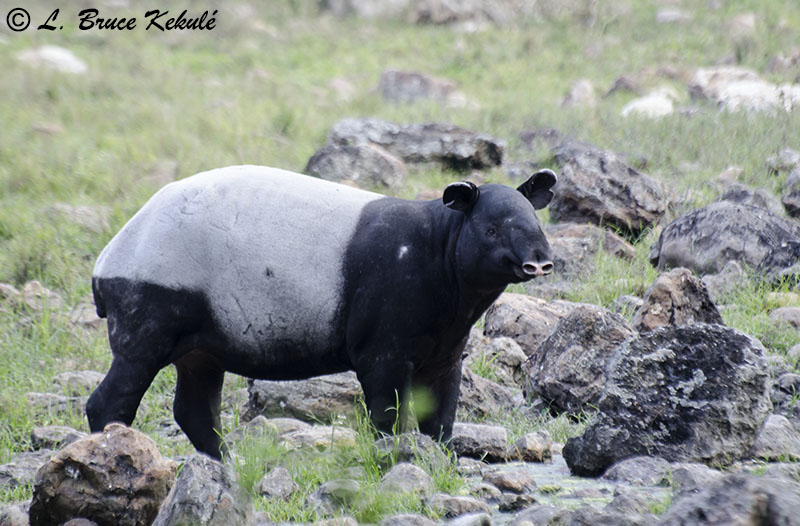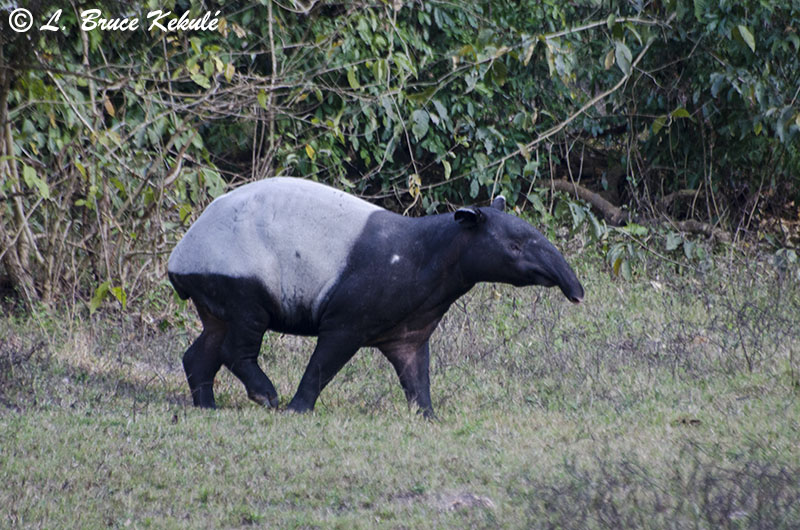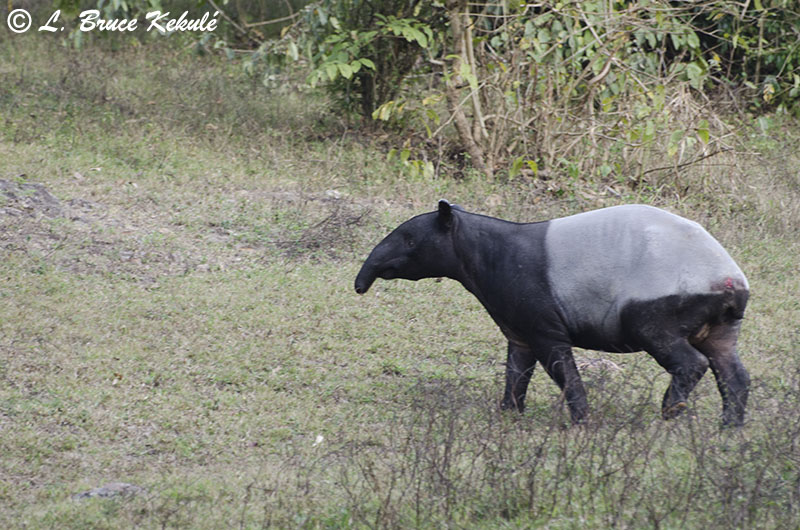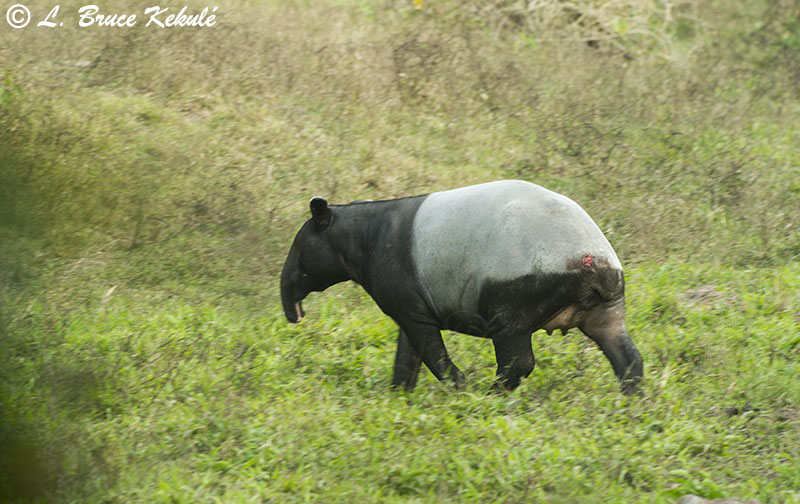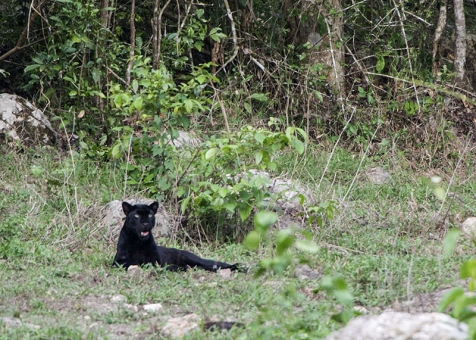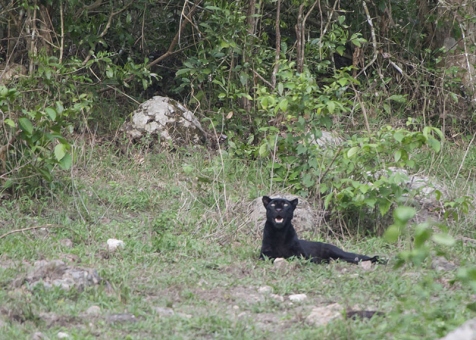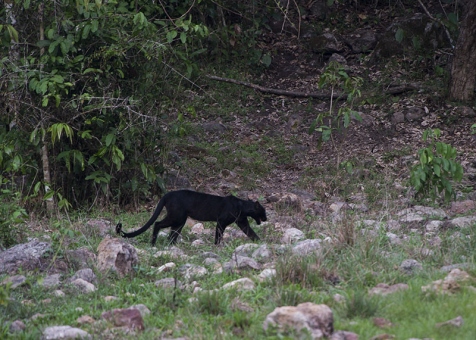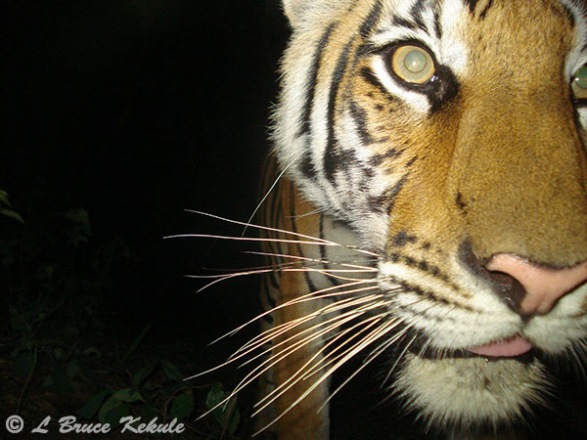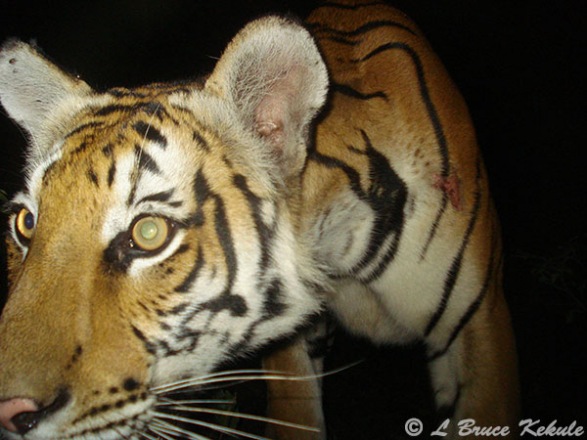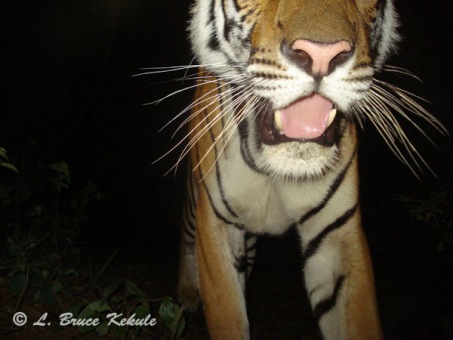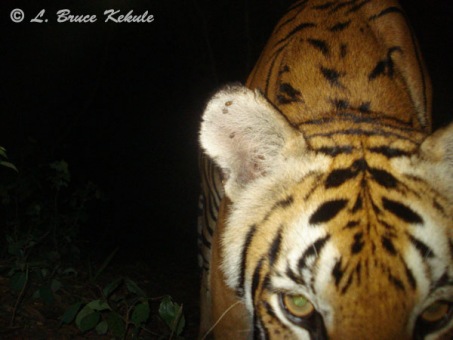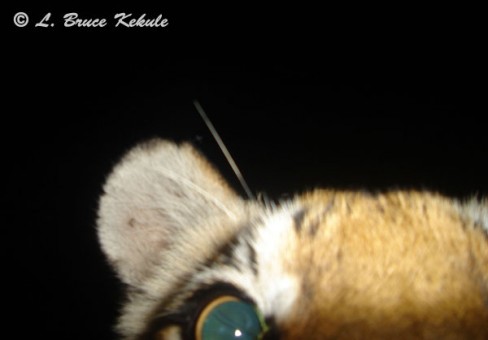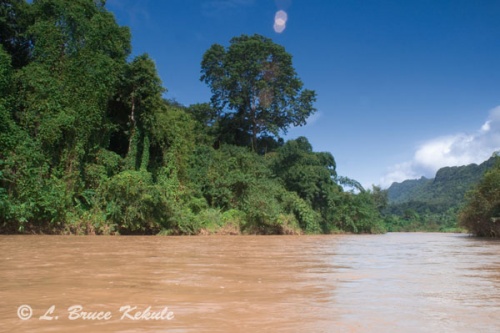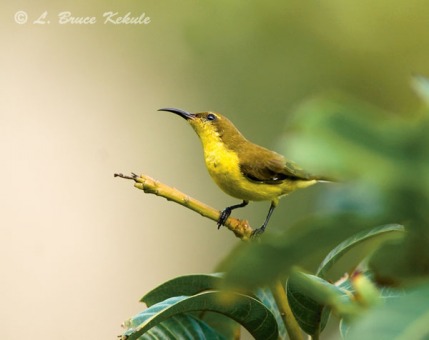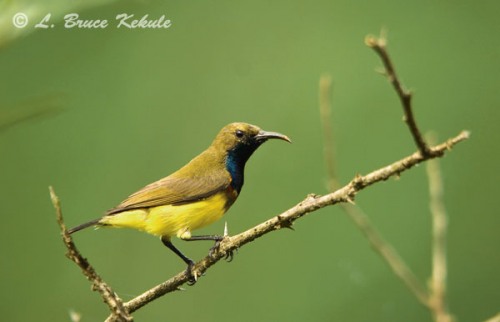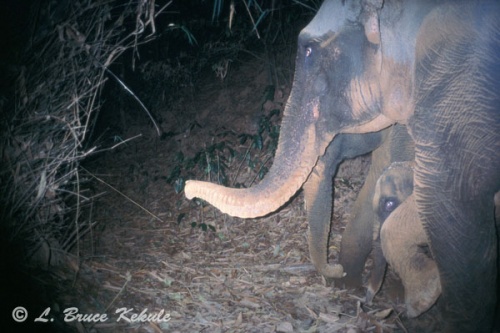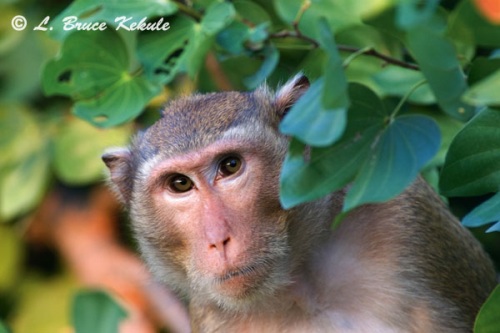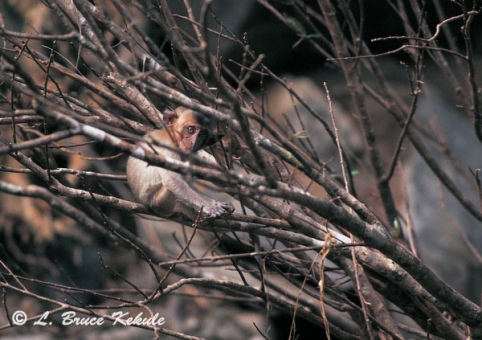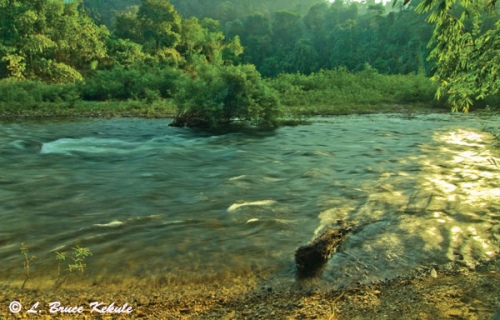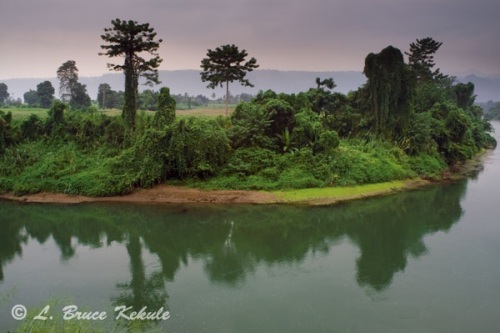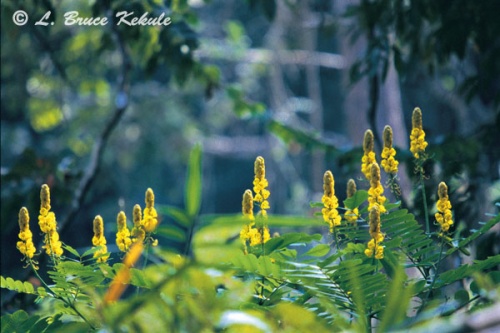Posts Tagged ‘western Thailand’
An Indochinese tiger caught by a Canon 600D: my favorite tiger image..!
After a few years of DSLR camera trapping in the Western Forest Complex of Thailand, I have finally chosen an image of a male Indochinese tiger caught one afternoon at 4.41pm that is my all-time favorite. For this location, I built a Canon 600D with an old Nikon 50mm manual lens incorporating an adapter (Nikon to Canon) in a Pelican 1150 case with an external Snapshotsniper SS II sensor on a 10-meter hardwire, and two SB28s in Tupperware® style boxes also on 10-meter hardwires. This mature tiger was out hunting when he passed the cam and the manual settings were ISO 400; ƒ8; 1/100 sec. and this shot was the last in a string of six. Enjoy…!
When it rains tapir, it pours tapir…!
A rare late afternoon capture of an Asian tapir Tapris indicus
A female tapir at a mineral hot spring in the Western Forest Complex of Thailand…!
Recently (Nov. 2014), I caught a female tapir that looked pregnant on my Canon 400D trail cam down in Southern Thailand at Khlong Saeng Wildlife Sanctuary located in Surat Thani province far off the beaten track.
First shot coming down the hill …!
The site is 60 kilometers by boat into the protected area. I got some really nice shots of the odd-toed ungulate as it moved along a wildlife trail on a ridgeline down to the reservoir. Also got a beautiful clouded leopard even though it was a bit out of frame. I counted my lucky stars…!
I have named this old girl ‘White Spot’ seen on her right shoulder…!
Then, I went back to Bangkok for some rest and after a few days, decided to go into my favorite protected area in the ‘Western Forest Complex’ to check and set-up a couple trail cams, and to sit in a photo blind where I got a black leopard 16 years ago, and then again in 2013.
What a pose with her rear leg extended just like a pedigree dog…!
I recently missed a black cat here when my Nikon 400 ƒ2.8 lens went on the blink in November last year. In 2010, I camera trapped a tapir in the morning just down from the blind. It has been a marvelous place and I have caught many species of Asian wildlife through the lens and by camera trap that come to the hot spring.
She must have heard me rustling in the leaves…!
As I was setting up my Canon 400D trail cam below the photo-blind, I got a bit frustrated as the camera would not trip after setup and so I left it. I was only 15 meters away from the blind. Somehow, I had nudged the control button to ‘Auto’ as I was to find out the next day.
And she high-tailed back up the hill but stopped short and came back down…!
I got five-steps, and there stood a female tapir out in the open coming down the hill to the hot spring. As I always carry a Nikon D7000 and a 70-300mm VR lens, I immediately started shooting.
Making her way back down to the mineral hot spring…!
I was also out in the open but as she looked the other way, I moved a little bit closer to get to my big lens (Nikon D3s and 200-400mm VR II) sitting on a tripod ready for action.
Still has not seen me…!
Tapir have very poor eyesight but hearing and smell are good. She must have heard me as she bolted back up the hill. She stopped short and then came back down. I was still shooting with the D7000. I finally got into the blind and started shooting the big camera. It was very exciting to see this odd-toed ungulate as they are nocturnal for the most part and hardly ever seen in the day.
A female for sure and a large wound on her rump: maybe a tiger or leopard, or wild dogs…!
I know of someone who has spent many years trying to photograph this species with no luck. He once spent 10 days at this hide unsuccessfully and then at another location for eight days. He left the sanctuary in despair and has been chasing them ever since..!
The moral of this story: Have a camera over your shoulder at all times if you are in the forest working or traveling through. You never know when something might pop out…I learned this from a National Geographic staff photographer (William ‘Bill’ Albert Allard) when he was here in Thailand as we chased down domestic elephants for a story in N.G. magazine…!
He said: “if you don’t have a camera, you aren’t going to get a shot”. It was a neat job and the pay was great. But it was the knowledge and ‘tricks-of-the-trade’ I picked up from him that has really paid off over the years. I think he took a shower with a camera around his neck..! Needless to say, I always have one ready just in case. I might have missed this tapir if I had left it up in the blind…! Enjoy
A ‘Black Leopard’ again..!
An extraordinary sighting in Huai Kha Khaeng Wildlife Sanctuary
A black leopard resting at the hot spring.
Sometimes things happen in succession that boggles the mind. On May 6th I posted a tale about a ‘black leopard’ plus other Asian wild animals caught by my Sony S600 cam on a trail into a hot spring in Huai Kha Khaeng Wildlife Sanctuary, western Thailand where I’m currently running a camera trap program.
Entering the hot spring.
I also mentioned in the story that I photographed a ‘black leopard’ from a tree blind some 15 years ago just up the trail a bit. The ‘leopard spots’ image is one of my all-time favorite wildlife photographs ever. http://brucekekule.com/camera_trapping/a-black-leopard-passes-my-camera-trap/
Leaving the hot spring.
On May 7th, I was back at the hot springs to set camera traps, and to sit at the base of the old tree for some through-the-lens work. Who knows what might show-up.
I was with my friend Sarawut Sawkhamkhet, a Thai wildlife photographer. We arrived and set-up a temporary blind about 3pm. The weather was warm and balmy with nice clear-blue skies.
A full-frame shot.
At 5:45pm, the unthinkable happened! A ‘black leopard’ appeared out of the forest near the springs and walked over for a drink, and then disappeared for a short while. Then the magnificent creature came back and flopped down on all fours twitching its tail looking straight at us staying for about 10 minutes before going back in the forest where it had come from.
Kabook Kabieng hot springs deep in the interior.
I would venture to say, this is the same cat I camera trapped back in February and it could also be an offspring of my original leopard back in 1998. Who knows? I was elated to say the least.
To see and photograph a black leopard once again at this same location after all these years is something out of the extraordinary. When time permitted, I set one of my trusty Sony S600 cams at the hot spring and will go back in a couple of weeks to see what has visited the waterhole.
Then I intend to set a DSLR Nikon or Canon camera trap with several flashes for improved images. This place is truly worth the effort, time and difficulty to get here. I look forward to more incredible images from this wildlife haven.
Photogenic Indochinese tiger
This series of camera trap images of a young tigress was collected in Huai Kha Khaeng Wildlife Sanctuary with a Sony W55 homebrew trail cam during May of this year. This particular tiger does not seem bothered by the flash and I have caught her several times prior to this set. Some animals don’t mind flash while others do. I have a tiger on video growling and back-tracking after seeing the red-LEDs on a Bushnell Trophy Cam. I tend to believe it all depends on the individual animal.
Note the wound on her left flank and ticks in her ears.
Huai Kha Khaeng: A birthday tiger and leopard
A new Sony W55 trail camera catches the big cats
On May 19th (my birthday) 2012, I decided to celebrate in the forest after returning to Thailand from a two-week photographic safari in Africa. It was once again a great trip to the Dark Continent and I managed to photograph the ‘Big Five’ (three times now) plus a multitude of other animals including some rare species like black-mane lion, black rhino, striped hyena, sable antelope and bush baby. I also got many other common animals like elephant, buffalo, giraffe, zebra, warthogs and antelopes. I also managed to catch Mount Kilimanjaro when the clouds lifted. Kenya is absolutely one of the greatest natural spectacles on the planet and I look forward to returning next year.
A male leopard caught by a Sony W55 homebrew trail camera trap
However, there are still a few wild places in Thailand that harbor many magnificent Asian creatures such as tiger, leopard, elephant, gaur, banteng plus many other mammals, birds, reptiles, insects and plant species. Huai Kha Khaeng is one of the top wildlife sanctuaries in Southeast Asia, and the world for that matter.
Leopard caught again checking out the camera
To get there, it takes about five hours by vehicle from Bangkok and is tucked away in the forested mountains of central-western Thailand in Uthai Thani province. I have written many stories about this place and its wildlife, and it never fails to live up to its status as a ‘World Heritage Site’ but this time it turned out even better than my wildest dreams.
A young female tiger caught by the Sony w55 trail cam
My birthday wish to catch a tiger and leopard up-close with one of my camera traps was granted by the ‘spirits of the forest’ and all the hard work building the cams, setting them up, waiting while they soaked and then the pain-staking collection was truly worthwhile.
My favorite shot of this young tiger
Arriving early in the morning, I got everything ready and went out to check the cams. One location has been extremely productive and had been very lucky catching tiger and leopard almost every time (three months in a row). When I went through the photos on my new Sony W55/SSII/1020/3 AA externals, I could not resist shouting out loud with one big hurrah. A leopard had stopped at the cam for a few shots and a night later, a tiger posed for a whole series of close-ups from the low-down set-up. I was speechless for a few seconds.
Check-out the ticks and markings on the right ear
Remember this tiger eye and ear
This game trail is situated deep in the protected area and many animals use it to get to a mineral lick and waterhole. The balance of nature is in full force here and ‘eat or be eaten’ carries on everyday. There is a fallen tree right across the trail about 500 meters from the dirt road some 15 kilometers in the sanctuary.
More ticks and note the wound on the left shoulder
Both of these big cats jump this log as they hunt for prey but usually a few days or two apart. The leopard is a very mature male but the tiger is a young female that seems to may have finally left her mother. I have a close-up shot of this same cat captured together in March and identified it as the same tiger two months ago by markings on the right ear. What a coincidence!
Stripe-pattern on right side used to identify this cat
All I can say is: this has been the best birthday in many moons and I know that my prayers are really answered from time to time. It is hoped this young tiger will continue to live out its life in safety and carry on its legacy as the world’s largest cat. Huai Kha Khaeng is truly a remarkable place and I have not even scratched the surface of this amazing wilderness!
Sai Yok National Park: Home of the Regal Crab and Kitti’s Hog-nosed Bat
Amazing biodiversity in jeopardy made famous by the ‘Death Railway’ in World War II
On December 8, 1941, the same day of the Pearl Harbor attack in Hawaii (Dec. 7 in the U.S.), the Japanese Army invaded Thailand with thousands of troops and settled in. Sometime in 1942, a decision was made to build a railway from Bangkok to Burma and beyond through the thick malaria and tiger infested jungles in Kanchanaburi province using allied and Asian prisoners-of-war as construction labor.
Regal crab by the Mae Nam Noi river in Sai Yok National Park
Thousands died under the harsh and sometimes brutal conditions. Remnants of this rail line remain today in Sai Yok National Park. Numerous monuments to the men who lost their lives have been erected in Kanchanaburi, and the main cemetery in town is close to the rail line and the famous ‘Bridge over the River Kwai’ (Khwae).
Apart from its popular waterfalls and river trips, this national park is not that well known. Situated in Kanchanaburi province, along Thailand’s western border with Myanmar, its interior is truly a magnificent wildlife paradise encompassing exactly 500 square kilometers. However, it may not remain so for long, as poaching and forest encroachment continues to be a problem for the Department of National Parks (DNP).
Kitti’s Hog-nosed bat in a limestone cave by the Mae Nam Noi
The headquarters of the protected area is at Sai Yok Yai (big Sai Yok) waterfall, about one hundred kilometers upstream from Kanchanaburi town on the Khwae Noi River. This site is visited by scores of local and foreign tourists every year that come to see the waterfall and the smaller one at Sai Yok Noi, both of which are only a short distance off Highway 323 going north. Activities on the river include swimming, rafting, boating and picnicking.
Cave-dwelling Nectar-eating bats in a limestone cave by the Mae Nam Noi
Deep inside the park, however, one of the world’s smallest mammals, Kitti’s hog-nosed bat Craseonycteris thonglongyai discovered by the late Thai zoologist Kitti Thonglongya, is found in limestone caves along the remote Mae Nam Noi and Khwae Noi rivers. Previously, it was thought to be endemic but now this creature has been found in other isolated pockets elsewhere in Kanchanaburi, and is also thought to survive in neighboring Myanmar.
Short-nosed fruit bats
This flying mammal weighs barely two grams. Aptly, it has been called the ‘bumblebee bat’ and has an average wingspan of just three inches. It uses sonar to forage for insects during short periods each night — about 30 minutes — in the evening and again for 20 minutes just before dawn. Numbers are few and is listed by IUCN as vulnerable. At one time, this remarkable little mammal was in fact one of the world’s twelve most endangered animals. Constant foraging by locals for bat dung (guano) and catching bats with mist-nets is a serious problem that needs to be addressed.
Sunset over Sai Yok National Park
Also found in this same area is the regal crab or queen crab Thaiputsa sirikit discovered in 1983 and named in honor of Her Majesty Queen Sirikit of Thailand. This crustacean is known locally as the ‘three-colored crab’. With their white body, purple stripe down the back, and red legs, the regal crab is truly a pretty sight.
Mae Nam Choan tributary in Sai Yok
They live like most crab, in holes, which they dig along the banks of the river. They come out at night to forage for food eating mainly composted leaves. Now few in number, this is yet another species that is seriously endangered and needs complete protection.
Olive-back sunbird female by the river
Fortunately, the locals in the area have stopped eating them since they were named after the Queen. They are now protecting the few crabs that are left. This is a case of true conservation and hopefully, the species will survive into the future.
Olive-back sunbird male close by
Elephant, gaur, tiger and leopard, plus many other species, still survive in the interior of the park, but all wild animals are dwindling. Sambar, serow, muntjac, tapir and wild pig are also found and constitute the main prey species for the big cats. Asian black bear, Malayan sun bear, clouded leopard, golden cat and marble cat plus many smaller species like civet, porcupine, gibbon and monkey live here but like all the rest, they too are threatened. Birds, reptiles, insects flourish as well as plant life.
Mae Nam Noi river in Sai Yok
Like most national parks in Thailand, Sai Yok is a target for poaching and logging which seem to go hand in hand. Most of the wildlife is hunted for trophies and meat, primarily during the dry season when there is good road access. It is sometimes common to see poachers in the park, cruising along the roads in vehicles or on motorcycles. Illegal logging has been carried out along the Khwae Noi, Mae Nam Noi and Mae Nam Lo rivers. This has seriously eroded their banks.
Mae Nam Lo river in Sai Yok
Other forms of encroachment include cattle and buffalo corrals that are set up deep in the forest where fodder is easily available. The chance of ‘foot and mouth’ disease being passed on to wild ungulates is real. Fruit orchards pop up in areas along the river inhibited by wild creatures and seem to thrive. Constant illegal activities are affecting the status of the park’s wildlife and watershed integrity.
Leopard camera trapped in the interior of Sai Yok
The forests in Sai Yok are mostly tropical broad-leaved evergreen with much bamboo and mixed deciduous woodlands in the foothills. The highest peak, Khao Khewa, at 1,327 meters above sea level, is part of the Tenasserim Range that runs through the park from north to south. The area was formerly logged so the park has many thin patches where big trees were felled. However, heavy brush continues to grow back strongly in these areas.
Elephants camera trapped by the river
During the height of the rainy season, between July and October, Sai Yok’s wildlife roam and feed fairly safely due to the rough weather and almost impenetrable terrain. The rivers and streams in the park become raging torrents that make crossing them next to impossible. About the only way in is by long-tailed motorboat, with a very skilled operator.
Mae Nam Lo river deep in the interior
Many a boats and rafts has been washed away in rapids on the Mae Nam Noi and Mae Nam Lo rivers. Occasionally, 4×4 off-road vehicles become stuck in the park after heavy rains. Some have even had to wait until the dry season to get out. Elephant just love to play football with these vehicles left behind. I know a man who left his Land Rover through the rainy season and when he returned, it had been flipped over and completely smashed.
Crab-eating macaque by the Lo River
Another very important aspect of Sai Yok is that gaur and elephant come across the border from Myanmar to feed on bamboo shoots in August and September, and then return to the safety of the other side prior to the dry season. Equally interesting, there are unofficial reports of a ‘hybrid cattle’, possibly a cross between gaur and banteng that have been seen by locals.
Young crab-eating macaque with a troop
The numbers of all animals are dwindling, however, due to increased activity in the park. Just a decade ago, green peafowl were found here but they have neither been seen nor heard from for many years. The ever-shrinking wilderness area of Sai Yok is under threat that should be addressed by the DNP if its flora and fauna are to survive intact.
Mae Nam Choan river
Sai Yok has always been special to me. I basically began my career as a wildlife photographer here after making a promise to the ‘spirits of the forest’ to begin documenting Thailand’s wildlife with a camera. Some of my first photographs are the regal crab and the Kitti’s hog-nosed bat shown in the story. I also camera trapped my first and second tiger in the interior. I recently caught a leopard by camera trap along a trail by the river seen here.
Khwae Noi River in Sai Yok
The future of Sai Yok as one of Thailand’s most beautiful and important national parks depends in great measure on the DNP and their ability to enforce the law. Reportedly, greater efforts are being made by the department to protect the park and its precious wildlife and ecosystems. Some poachers and encroachers have been arrested but such campaigns can be difficult to sustain. The long-term effects will become clear over time.
Candlebra bush flowers in the interior
It is hoped this magnificent wilderness and its wildlife will survive into the foreseeable future. In particular, the home of the world’s smallest bat needs serious attention and protection. It would be a sad day for Thailand if this prestigious mammal were to be lost to extinction.



